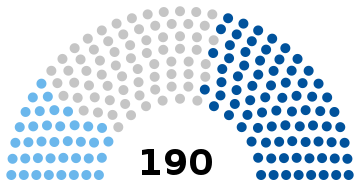1866 Swedish general election
 |
|---|
General elections were held in Sweden in 1866. They were the first elections for the new Second Chamber (Andra kammaren) in the Riksdag, which would serve a three-year term. Suffrage was given to men over the age of 21 who either had a taxable income of at least 800 riksdaler a year, owned a property worth at least 1,000 riksdaler, or rented a property taxed to at least 6,000 riksdaler.[1] This meant that around 5.5% of the population were able to vote, a slight reduction from the 6% that had been eligible under the previous Estates system.[2] The changes had been approved following a 60,000-strong petition and a vote in the House of Nobility in December 1865 during which crowds had gathered outside to pressure the nobles into approving it.[2]
The 190 seats consisted of one representative from every Domsaga (or two for Domsaga with a population exceeding 40,000) and one representative for every 10,000 residents of a town (with smaller towns merged into combined constituencies).[1] Candidates were required to be at least 25 years old.[1]
Around 187,000 voters qualified by real estate, 9,500 through their rental arrangements and 10,500 through their income. Many property owners were farmers, giving the rural Lantmanna Party a dominant position in the second chamber.
The other house in the Riksdag, the 125-seat First Chamber, was dominated by the upper classes, with membership restricted to the 6,000 wealthiest people in the country, less than 1% of the population.[2]
Results
Of the 190 elected members, 107 had previously served in the Estates.[2]
 | ||
|---|---|---|
| Party | Seats | |
| Lantmanna Party | 81 | |
| Ministerial Party | 38 | |
| Independents | 71 | |
| Total | 190 | |
| Source: Norberg et al.[3] | ||
